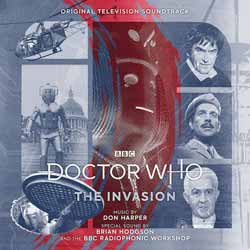|
Click here to return to the main site. Soundtrack Review
Featuring the Brigadier, UNIT and the Cybermen, The Invasion was an eight-part Doctor Who story made and transmitted in 1968. Written by Derrick Sherwin (from a story by Kit Pedler), it starred Patrick Troughton as the Second Doctor. At the helm was Douglas Camfield, one of popular television’s most maverick and talented directors in the 1960s and 1970s. The music was composed by Don Harper, the third Australian émigré composer (after Ron Grainer and Dudley Simpson) to work on the programme. The master tape of the music for The Invasion was lost soon after transmission, but Harper retained a 7½ ips ‘composer’s copy’ that forms the basis of this release. The score is augmented by the extensive use of electronic sounds by Brian Hodgson of the BBC Radiophonic Workshop… Don Harper’s music for The Invasion has aged rather better than many purely electronic scores composed for Doctor Who during the same period or even decades later. With the exception of “The Dark Side of the Moon”, many of Harper’s compositions sound more like music from an espionage thriller than that of a science-fiction story featuring invaders from space. Witness moody tracks such as “The Company”, “Mysteries” and “Fire Escape”. It’s an entirely fitting tone given the emphasis on corporate intrigue and military action in this serial, in which the Cybermen don’t actually emerge until halfway through the story. The composer may have been influenced by John Barry’s score for The Ipcress File (1965), and there’s also a hint of Barry’s 007 strings in “Hiding”. More strings combine with nerve-jangling percussion and screaming wind instruments for “The Cybermen, My Allies”. Offsetting such edginess is the light and jaunty “Brigadier Lethbridge-Stewart”, which rides in to the rescue. These tracks are followed by untitled numbers that were composed for the serial but never actually used. Many of them are short, shock cues (known in the business as stings) and/or variations on themes heard earlier on in the score, though it is a pity that the upbeat “Music 9” was never heard on screen. Similar in mood to “Brigadier Lethbridge-Stewart”, it would have gone well with some of the UNIT action. Harper made use of a cimbalom, a type of chordophone comprising a large, trapezoidal box with metal strings stretched across the top. This was most likely played by John Leach (who also worked under the name Janos Lehar), who performed on The Ipcress File, King Rat (1965) and The Persuaders! (1971–2). Other instruments used included the organ, percussion, clarinet (doubling clarinets in A and Bb, bass clarinet and oboe), bass guitar, contra-bass clarinet and cor anglais. The percussion consisted of bim bams and temple blocks, timps including piccolo timp and hand timp, as well as cymbal and vibraphone. The organ was a Hammond M100 with a Leslie speaker. Also included among the music tracks is “Muzak” (referred to as such in the cue sheets for Episodes One and Two), a composition by John Baker that had previously been heard in the Out of the Unknown episode Time in Advance and the Doctor Who serial The Macra Terror. Special sounds by Brian Hodgson of the BBC Radiophonic Workshop also make a significant contribution to the soundscape of The Invasion. Try to imagine the cliffhanger endings of Episodes One, Four and Six without the harsh but hypnotic tones of “Cyber Director Appears”, “Cyberman Brought to Life” and “Cyber Invasion”, compositions that work almost like music rather than mere sound effects. These tracks give the story its science-fiction flavour, counterpointing the espionage themes of Harper’s work – though the two styles do find their meeting place in Harper’s “The Dark Side of the Moon”, which manages to be both edgy and otherworldly. Hodgson later reused “International Electromatics Headquarters Interior” as a cockpit background in The Ambassadors of Death, while a short section from “TARDIS Take-off Slow and Painful” would be heard again when the Fifth Doctor’s ship ran into trouble in Warriors of the Deep. Take care, though, because some of the special sounds are very long. “Cyber Invasion” lasts for nearly eight minutes, while “International Electromatics Headquarters Exterior” goes on for ten and a half. Don’t fall victim to the Cyber-hypnotic signals! 9 Richard McGinlay Buy this item online
|
|---|


